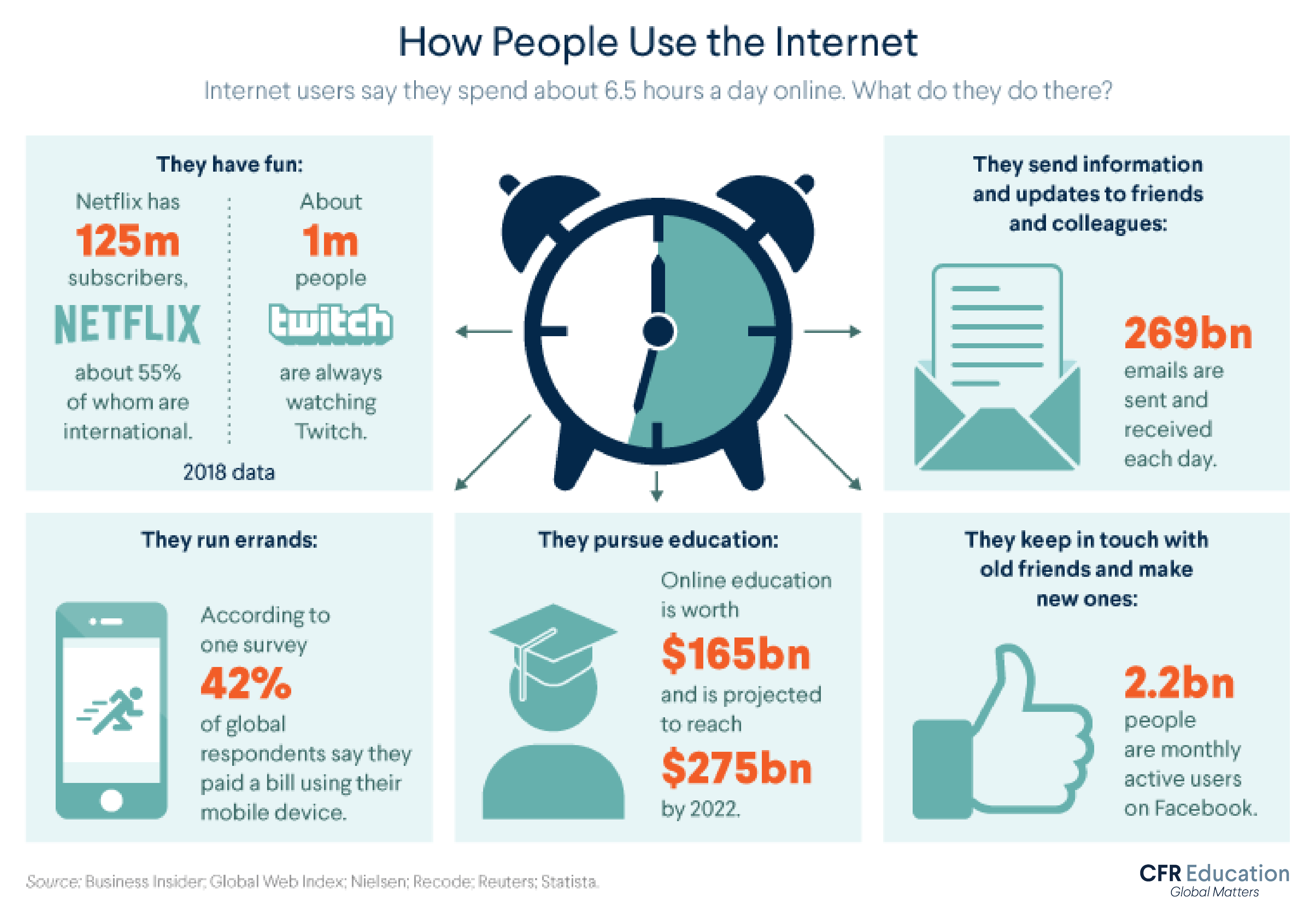The Internet by the Numbers
In a world where internet access is increasing, digital divides remain.
In less than two decades, the number of people with access to the internet has skyrocketed. As of April 2022, more than 5 billion people used it worldwide, which is 63.5 percent of the world’s population—up from just 15 percent in 2005. Much of that increase is concentrated in the developing world.
At the same time, the internet shapes people’s lives today more than ever before. .
The internet influences the world profoundly, in ways both beneficial and harmful. The rise of digital tools and the expansion of the internet has benefited world affairs and individual countries’ goals, driving improvements in global health, education, national security and more. But the internet’s growth also carries risks such as, cyberattacks and the spread of false information. Increasing online space has also led some countries to clamp down on internet access threatening freedom of expression around the world. Explore those issues in the sections that follow.
Even though the internet seems like it’s everywhere, it’s not.
More people in developed countries enjoy internet access than people in developing ones. In approximately twenty countries, less than 20 percent of the population uses the internet. To put that in perspective, 93 percent of the U.S. population uses the internet, and four countries have 100 percent internet access: Bahrain, Liechtenstein, Qatar, and the United Arab Emirates.
In some countries, it can be hard to even turn on the lights, let alone log on to the internet. More than one in ten people around the globe lack access to electricity.
But many countries are catching up quickly. For example, the percentage of people in China using the internet shot up from 2 percent to 70 percent between 2000 and 2020; in India, use went from just 0.5 percent to nearly half of the population over the same period.
Developed countries with overall higher rates of internet use nonetheless have an urban/rural divide and several demographic divides. For example, in the United States, 99 percent of adults from households earning $75,000 or more a year use the internet, compared to 86 percent of those from households earning less than $30,000. And 98 percent of college graduates in the United States use the internet, compared to 86 percent of those without a postsecondary degree. Use the line chart below to explore the differences between, and within, education level groups. (To explore other metrics, check out the data on Pew Research Center.)
What’s more, globally, girls and women have less access to technology and the internet than boys and men. In the world’s least developed countries, a “digital gender gap” of 32.9 percent exists between men and women. Gendered internet access gaps are wide in Africa, and in South Asia, unequal access to mobile phones persists, with women 26 percent less likely to own a mobile phone than men.
According to the U.S. National Telecommunications and Information Administration, about one in five U.S. households don’t use the internet at home. Major reasons for that gap in internet use include the following:
- disinterest: nearly 60 percent of respondents reported the internet wasn’t necessary or interesting to them.
- cost: about one-fifth of households that didn’t use the internet at home pointed to the price tag as the problem.
- lack of infrastructure: 4 percent of the unconnected at home said they didn’t have internet availability in the area.
Importantly, even with expanding access to internet technology, countries can control how much people have access to content and tools online (“online freedom”). Countries can have different policies governing online space—ranging from extremely restrictive control to more open approaches—which can in turn shape global cyberspace. For more discussion on internet control and social media, see “Social Media: Revolutionizing Communication,” and for discussion on the internet in global politics, see “Should the Internet Respect National Borders?”
At least one fact is constant across regions: young people are driving internet use.
Globally, 71 percent of people aged fifteen to twenty-four use the internet, compared with 57 percent of all other age groups worldwide.
Access to the internet gives young people opportunities to learn new information (by using educational tools such as World101), connect with friends and family, be civically active, and develop skills they need to succeed in an increasingly digital world. At the same time, the internet involves risks, including online attacks and the dissemination of false and dangerous information, that highlight the need to bolster its expansion with digital literacy. Getting online has only become more crucial in the COVID-19 era, with more than ninety countries conducting school virtually in 2020.
Older generations often think of young people as digital natives, assuming that they have never known a world without the internet. However, just as a generational gap exists in internet use, a digital divide also exists among the youth. About 1.3 billion young people (around two-thirds of the world’s youth) don’t have internet at home.
The digital divide mirrors the economic one among countries and regions. Only 6 percent of young people in low income countries have home internet access, compared to 87 percent in high income countries. That means millions of children—most of them in developing countries—are deprived of the opportunities the internet provides.
Closing those gaps in internet access for young people, and for all demographic groups, is especially crucial today as the world battles the COVID-19 crisis by going remote for work and school. The internet has transformed how people trade, make financial transactions, share ideas, and do so much more. In fact, the internet is so integral to economic development, and so central to every aspect of modern life, that bridging the digital divide has become an international priority: achieving universal, affordable access by 2030 is a target of the United Nations’ Sustainable Development Goals.

